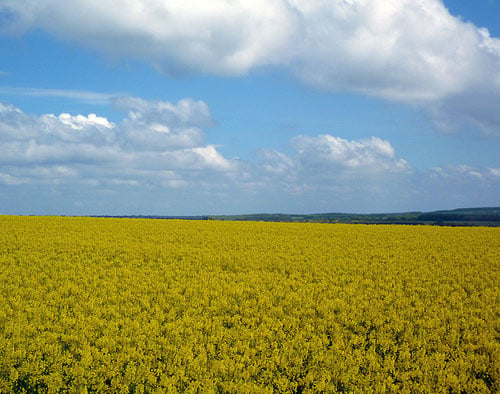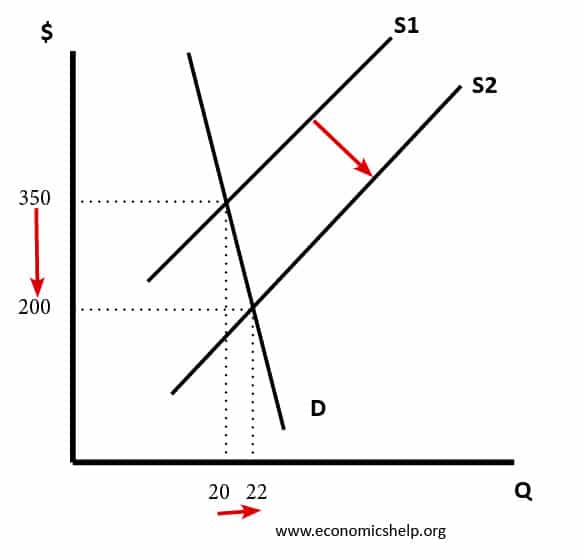Encourage Arts Manufactures and Agriculture by All Means in Their Power
Agriculture ofttimes appears to be one of the almost difficult industries, ofttimes leading to some course of market failure. In the EU and The states, agriculture is the most heavily subsidised industry, yet despite the cost of the subsidy information technology fails to accost many issues relating to agriculture.

Types of market failure in agriculture
- Volatile Prices / volatile supply
- Low and volatile income for farmers
- Environmental costs of intensive farming (negative externalities)
- Agriculture key component of rural life (positive externalities)
- Monopsony power of food purchasers.
Volatile Prices in Agriculture
Prices in agricultural markets are often much more volatile than other industries. This is because:
- Supply is price inelastic in the short term. (It takes a year to grow about crops)
- Demand is toll inelastic. (Food is essential, and people are non normally put off by higher prices)
- Supply tin can vary due to climatic conditions.

This diagram shows that a 'skilful' harvest leads to an increase in supply. This leads to a significant autumn in price ($350 to $200). See also volatile food prices
The problem of volatile prices is that:
- A abrupt drib in price leads to a fall in acquirement for farmers. Farmers could easily go out of business concern if there is a overabundance in supply because prices can plummet below cost.
- Cobweb theory. The cobweb theory suggests prices can get stuck in a cycle of e'er-increasing volatility. E.yard. if prices fall like in the above example. Many farmers will become out of business. Next year supply will fall. This causes price to increase. All the same, this college price acts equally an incentive for greater supply. Therefore, next year supply increases and prices plummet once more!
- In some years, consumers tin can be faced with a rapid increment in food prices which reduces their disposable income.
two. Low income for farmers
Often farmers don't share the aforementioned benefits of economical growth. As the economy expands, firms don't see a similar increment in income. Food has a depression-income elasticity of need. Equally incomes rising, people don't spend more on food. Besides, technological advances can atomic number 82 to falling prices rather than rising incomes. Many developed economies feel it is necessary to subsidise farmers to protect their incomes.
For a developing economy, their current comparative advantage may lie in producing master products. However, these may take a low-income elasticity of demand. With global growth, the demand for agricultural products doesn't increase every bit much every bit manufacturing. Therefore, relying on agriculture can lead to lower rates of economic growth.
3. Environmental costs of intensive farming
Mod technology has enabled increased crop yields. However, this oft requires chemic fertilizers which cause pollution. As farming becomes more than competitive, there is a greater pressure to produce more leading to increased use of chemicals. However, artificial fertilizers take diminishing returns, so it becomes more expensive and greater environmental toll for little benefit. Many farming methods have led to deforestation and cutting down trees. This tin upset the eco-rest making regions more susceptible to flooding.
4. Positive externalities of farming
You could debate farming communities play an integral function in rural life. If farmers become out of business, information technology has adverse consequences for rural communities and the environment they live in. This is ofttimes a justification for subsidising farmers (e.g. the social benefit of subsidising sheep farmers in the Lake District)
5. Monopsony
Supermarkets can have monopsony buying ability over local farmers. This means farmers may encounter their turn a profit margins squeezed by the big supermarkets who take substantial buying power. If farmers don't sell to the big supermarkets they can't sell their products; this is why information technology puts them in a hard position.
Government intervention in agriculture
- Buffer stocks – to aid stabilise prices though having minimum and maximum prices
- Minimum prices – to guarantee farmers basic income by subsidising food prices. Even so, minimum prices may encourage oversupply and atomic number 82 to wasted food product.
- Subsidies for farmers who follow more environmentally friendly methods.
- Tariffs on imports. This increases the domestic cost of agronomical produce, but leads to lower merchandise.
Problems of government intervention in agriculture
- Cost of subsidising agriculture in the developed world It is estimated support to agricultural producers in avant-garde countries was $245 billion in 2000, v times total development assist. In the members of OECD as a whole, a third of farm income came from government mandated support in 2000. (Martin Wolf, Financial Times, 21 November 2001) (bug of Agriculture)
- Subsidies have ofttimes been given to farmers with large amounts of state and with little incentive to follow more than environmentally friendly procedures.
- Minimum prices accept led to over-supply
- Tariffs on agriculture have led to lower income for food exporters in the developing world and have been a big stumbling cake to merchandise.
Related
- Problems of Common Agricultural Policy
- Regime intervention in agronomical markets
Photograph: A field in the Cotswolds by Tejvan
Source: https://www.economicshelp.org/blog/4977/economics/problems-of-agriculture-market-failure/
Post a Comment for "Encourage Arts Manufactures and Agriculture by All Means in Their Power"